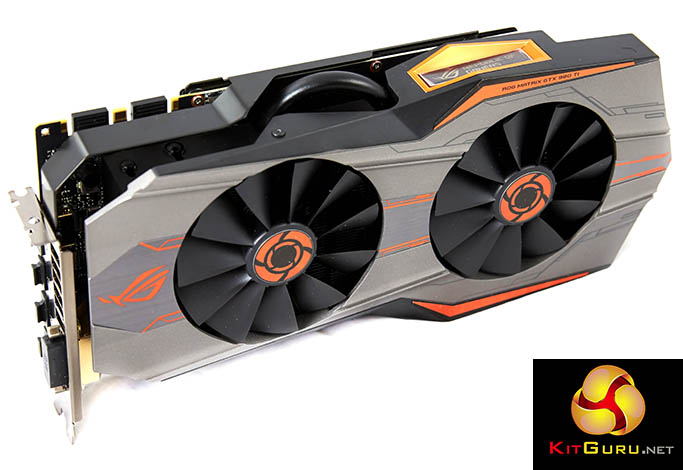If you have £700 cash in hand and are looking for the finest graphics card on the market, then the Asus ROG Matrix GTX 980Ti Platinum Edition should definitely make your final shortlist.
They say first impressions matter, and unboxing the Asus card was quite the experience. The card is beautifully put together, and the cooler itself is substantial in hand and fantastic to look at. No attention to detail has been spared – we particularly like the backplate, and the way that ASUS have coloured the heatpipes and aluminum fins with a special heat resistant black coating – to raise the aesthetic appeal.

The orange and two tone grey/silver colour scheme is both stylish and understated while the coloured lighting to indicate load status is effective and useful for troubleshooting potential issues.
Nvidia's GTX980 Ti has been king of the hill now since it was launched, and nothing has really changed since that day. While the Fury X is a great card set to satisfy the high end AMD audience, these modified GTX980 ti cards are simply in a performance league of their own.
With such high overclocked core clock speeds, the Asus ROG Matrix GTX 980Ti Platinum Edition is able to generate extremely high frame rates at 1440p, and many gamers would be happy enough with single card Ultra HD 4k performance. I personally prefer to get a steady 60fps at 4K, and this still will require an SLi configuration. Yes, super smooth 4K gaming is undoubtedly very expensive.
The Asus ROG Matrix GTX 980Ti Platinum Edition dominated our benchmark charts and outclassed all of the other Nvidia and AMD hardware on test today, apart from the dual GPU R9 295X2 which still manages to hold the top position in many of the tests. That said you need an effective Crossfire profile to get the most from dual GPU hardware and if there is no profile available then you are often playing a game with dramatically reduced performance. Many gamers don't want to rely on a Crossfire or SLi profile, regardless of potential gains. This is what makes a graphics card such as the Asus ROG Matrix GTX 980Ti Platinum Edition incredibly desirable.

The Asus ROG Matrix GTX 980Ti Platinum Edition is available for £659.99 inc vat. You will be able to buy it soon direct from Overclockers UK HERE.
Pros:
- class leading performance.
- high overclock out of the box.
- looks fantastic
- backplate.
- quiet.
Cons:
- We are not sold on ASUS GPU Tweak software.
- its expensive.
Kitguru says: The ultimate gamers wet dream? The Asus ROG Matrix GTX 980Ti Platinum Edition is one of the finest graphics cards we have ever tested.

 KitGuru KitGuru.net – Tech News | Hardware News | Hardware Reviews | IOS | Mobile | Gaming | Graphics Cards
KitGuru KitGuru.net – Tech News | Hardware News | Hardware Reviews | IOS | Mobile | Gaming | Graphics Cards



So how does this card compare to the MSI Lightning GTX 980 Ti, and the EVGA Kingpin 980 Ti? Are there significant differences, or is it too close to call?
we haven’t tested the kingpin, we did test the XLR8 model, which is a little lower in the chain http://www.kitguru.net/components/graphic-cards/zardon/pny-gtx980-ti-xlr8-oc/ – my colleague Luke tested the Lightning but I haven’t seen it myself http://www.kitguru.net/components/graphic-cards/luke-hill/msi-gtx-980-ti-lightning-6gb-review/
Nice card but I really wouldn’t want to be spending £650 on a Maxwell card so late in its life cycle, Pascal cards costing half as much will have roughly the same performance in 6-8mths.
So is this 2.5 slot or 3 slot, I keep being told 3 slot design.
then high end Pascal in Q2 2017
Allan, is this 2.5 slot or 3 slot, I keep being told it is 3 slot.
Why do you keep changing your GPU tests, makes it harder to compare due to different situations, stick to one way, if not test all the GTX 980ti again, I would like to have a comparison of GTX 980ti Lightning and the ASUS GTX 980ti Matrix
It’s 2.5 slot.
Source? Even if true, GTX680 outperformed GTX580 by 35% at 1440P on day one of release, and had better feature set and driver support. That means in 2016 we’ll should have a 16nm $500-600 card from AMD/NV that should be 30-40% faster than 980Ti. It won’t be double the performance but it’ll likely have 8GB of memory and better feature set and most importantly the latest driver focus (*Kepler gimping* ahem).
One is the 16nm fab is new…and untested…and you can’t go large and power hungry on first generation chips. Don’t believe how unreliable a new fab is? Look at how long it took Nvidia to pick between Samsung and TSMC and finally siding with TSMC due to their longer working history and reliability.
Second point is…they will kill their own sales by offering their best card right at the release of the new generation. They will not be able to give any reason at all to their enthusiast market to upgrade their card within 3 years of launch. Whereas when you look at Kepler, people bought the 680, then the Titan came out, then the 780, and most people who bought the 680 eventually upgraded to those cards. And then when Maxwell launched, they started with just the 750 and 750ti. Then released the 980 that some bought, and finally after a while, the Titan X and 980ti which gave people (enthusiast market, again) a reason to upgrade.
Nvidia likes incremental upgrades. They don’t want you to buy a card now, and launch another card in a year that completely destroys the card you bought. They put out one card, then 12 months later they bring out another card that is generally just 10-20% faster, so it’s better than what they offered before, but not enough to piss off anyone who bought their last gen cards. And then another 6-12 months later they put out an even better card, with 50%+ better performance than their older cards, and people start upgrading again.
If on day one of the Pascal launch, if they come out with their absolute best card, they are going to have nothing interesting to bring to market for 2 to 3 years until Volta comes out. And that would be silly. Even if it were possible with the new 16nm fab. In terms of business, you need to offer a product that is a bit better than your competition, without being too much better/too costly for you. So they just need to put out a slight performance increase, but sell the card on much lower power consumption, wait for AMD to release something else, and then launch a bigger die version themselves, and back/forth they go. Just a quick reference:
FERMI
———–
GTX 580 = 520mm2
KEPLER
————-
GTX 680 = 294mm2
GTX Titan = 551mm2
MAXWELL
—————
GTX 750ti = 148mm2
GTX 980 = 398mm2
GTX Titan X = 601mm2
Do you see the pattern? Small, Medium, Big, restart. Don’t think about it based on die size. Because it’s really just about transistor count. Pascal at 16nm, even a 294mm2 sized die like the GTX 680, along with HBM2, would result in performance close to the Titan X…and perhaps even higher due to lower heat/power consumption allowing higher clocks.
Hope that helps.
Also NVIDIA has not even released the GTX 990, so why would high end Pascal come out in Q1 2016, no one would buy the GTX 990
Also, you really think it will be 30 percent, node shrinks do not increase performance. It will be the same performance in games. Also we are comparing a GTX 980t, not the GTX 980, the GTX 1080 will have the same performance as the GTX 980ti
https://www.youtube.com/watch?v=Lqq6gJlKvtk
There you go, all you need to know 🙂